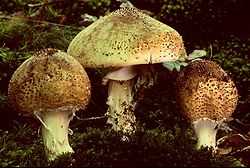Lepiota aspera
| Lepiota aspera | |
|---|---|
 | |
| Conservation status | |
| common | |
| Scientific classification | |
| Kingdom: | Fungi |
| Division: | Basidiomycota |
| Class: | Agaricomycetes |
| Order: | Agaricales |
| Family: | Agaricaceae |
| Genus: | Lepiota |
| Species: | L.aspera |
| Binomial name | |
| Lepiota aspera (Pers.) Quel. | |
| Synonyms | |
|
L. friesii (Lasch.) Quel. | |
| Lepiota aspera | |
|---|---|
|
| |
| gills on hymenium | |
|
cap is ovate or campanulate | |
| hymenium is free | |
| stipe has a ring | |
| spore print is white | |
| edibility: unknown | |
Lepiota aspera; sometimes known commonly as the Freckled Dapperling, is a large brownish; white gilled mushroom, with a warty or scaly cap. It lives in woodland, or on bark chips in parks, and gardens.
Taxonomy
Noted by two of the most eminent nineteenth century mycologists (Persoon & Fries), the Freckled Dapperling has been back and forth through many taxonomical name changes. For a time; it was placed with the so-called spiny Lepiota species into a separate sub-genus called Echinoderma, and was also placed into Cystolepiota. However; the most recent and widely accepted binomial name is Lepiota aspera (Pers.) Quel.[1] The genus name Lepiota coming from the Greek, and meaning 'scale', which probably refers to the cap surface.
Description
The cap is oval at first; becoming convex, or campanulate with age. Uniform reddish/brown, or brown at the centre; breaking up into erect scales, on a paler ground, and up to 10cms in diameter. The stem is paler; around 10cms in length, and has sparse brown scales below the ring. The ring itself is large and cottony; sometimes adhering to the cap perimeter, and often taking brownish scales from there, which are seen at its edge. The gills are free; crowded, and white, with the spore print being white also. The flesh is white, and is said to smell of rubber; earth balls,[2] or Lepiota cristata.
Similar species
Check Lepiota; Macrolepiota, and Amanita species.
Distribution and habitat
Lepiota aspera appears during autumn; in deciduous woodland, or in parks and gardens where 'wood chip' mulch has been used. It has been recorded in most northern temperate zones; England; Europe, and North Africa.[3]
Edibility
This mushroom has been shown to cause alcohol intolerance and may be poisonous.[4]
See also
References
- ↑ Roger Phillips (2006). Mushrooms. Pan MacMillan. ISBN 0-330-44237-6.
- ↑ Marcel Bon (1987). The Mushrooms and Toadstools of Britain and North Western Europe. Hodder and Stoughton. ISBN 0-340-39935-X.
- ↑ Regis Courtecuisse and Bernard Duhem ((British version) 1995). Mushrooms and Toadstools of Britain and Europe. Harper Collins. ISBN 0-00-220025-2. Check date values in:
|date=(help) - ↑ PMID 21370948
| Wikimedia Commons has media related to Lepiota aspera. |